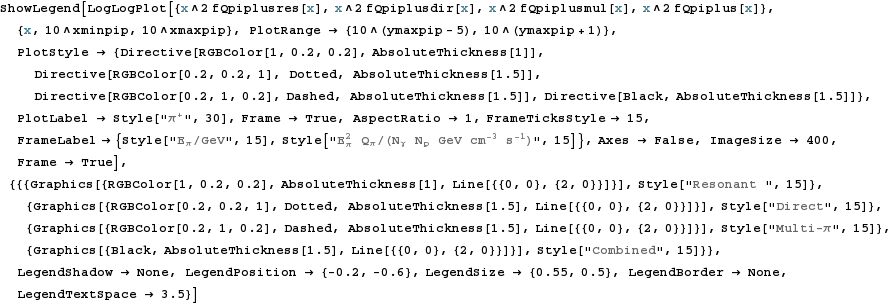Simplified Models for Photohadronic Interactions in cosmic accelerators
Authors : S. Hümmer, M. Rüger, F. Spanier, W. Winter
This notebook illustrates how to reproduce some results for model Sim - B of arXiv : 1002.1310. It calculates pion, kaon, neutron muon and neutrino spectra. Please cite arXiv: 1002.1310 if you use this notebook. The notebook can be downloaded here. Requires Mathematica 7.
General parameters
General note on units : All energies in this notebook
are in GeV. All spectra are in units of ![]()
![]() (steady) or
(steady) or ![]()
![]()
![]() (injection) times the normalization factors,
as given in App. C.
(injection) times the normalization factors,
as given in App. C.
Input Proton spectrum as a function of energy (Eq. C2)
In[1]:=
![]()
Input Photon spectrum as a function of energy (Eq. C1)
In[2]:=
![]()
Energy range for which spectra are to be calculated
This notebook needs about 10 minutes to run through for the considered energy range chosen to be [1 ...10^11] GeV (logarithmically). The distance between the interpolation points is in this case deltae = 0.5 [GeV]. For smoother/better results, adjust this number to 0.1 (affects the computation time by a factor of five).
In[3]:=
![]()
Switches off the messages regarding slow converging and undeflows in computations. For our accuracy, this treatment is sufficient.
In[5]:=
![]()
Description of photohadronics
Here the response Functions (f) and the parameters are defined for the different interaction types.
Resonant production (see Sec. 4.2.2)
General version of f-functions in Eqs. (31) and (32):
In[6]:=
![]()
Parameters from Table 4 in the form {emin, emax,
σ, χ,
![]() ,
,
![]() ,
,
![]() } for
different pion charges and interaction types {(LR;
} for
different pion charges and interaction types {(LR; ![]() ),(LR;
),(LR;
![]() ),(HR;
),(HR;
![]() ),(HR;
),(HR;
![]() ),(HR;
),(HR;
![]() )}
)}
In[7]:=

Direct production (see Sec. 4.3)
Functions ![]() :
:
In[8]:=

f-functions for single pion production (1) and 2-pion production (2) from Eq. (33):
In[10]:=

Parameters from Table 5 {emin,
emax, χ, ![]() ,
,
![]() ,
,
![]() ,
Z} for the different interaction types
,
Z} for the different interaction types ![]() ,
,![]() ,
,![]() ,
,![]() ,
,![]() ,
,![]() ,
,![]() };
here Z=1
for single pion production and Z=2 for 2-pion production
};
here Z=1
for single pion production and Z=2 for 2-pion production
In[12]:=

Multi-pion production (see Sec. 4.4.2)
f - function (see Eq. (40)) has the same general form as the one for resonant production
Parameters from Table 6 {emin, emax, σ, χ,
![]() ,
,
![]() ,
,
![]() }
for the different interaction types (see first column of Table 6):
}
for the different interaction types (see first column of Table 6):
In[13]:=

Kaon production (see Sec. 4.5)
f - function from Eq. (42):
In[14]:=
![]()
Computation of secondary spectra
Pion production; computed with Eq. (28) for the different interaction types; uses logarithmic integration and y as logarithmic variable
Pion spectra from resonant production
In[15]:=

In[16]:=

Pion spectra from direct production
In[19]:=

In[20]:=

Pion spectra from multi-pion production
In[23]:=

In[24]:=

Total pion spectra
In[27]:=

Kaon production; see Eq. (28)
In[30]:=

Neutron production; see Eq. (B6)
Resonant production:
In[31]:=

Direct production:
In[32]:=

Multi-pion production:
In[33]:=

Total neutron spectra :
In[34]:=
![]()
Figures for secondary spectra
Function constructing interpolating functions (Parameters: data: table for which to define interpolating function, xmin, xmax and ymax: to define ranges for the plots, func: interpolating function object to be returned)
In[35]:=

Calculation of the interpoalting functions for pion, neutron and kaon spectra
In[36]:=

In[44]:=
![]()
Contributions to the positive charged pion spectrum from resonant, direct and multi pion interactions (see Fig.5 top left corner)
In[45]:=

Out[45]=

Pion and kaon spectra (see Fig. 6 left panel)
In[46]:=

Out[46]=

Description of Weak Decays
Scaling functions for the decays of pions and muons
In[47]:=

Pion decays - Muon spectra
Here we compute the decays of the pions into left- and right-handed muons and construct the interpolating functions for the muon spectra (for explanation see module part1)
In[55]:=

In[56]:=

Pion decays - Neutrino spectra
Here we compute the decay of the pions into neutrinos and construct the interpolating functions for the neutrino spectra (for explanation see module part1)
In[60]:=

In[61]:=
![]()
Kaon decays - Neutrino spectrum
Here we compute the decay of the kaons into neutrinos and construct the interpolating functions for the neutrino spectrum
In[63]:=
![]()
Neutron decays - Neutrino spectrum
Here we compute the decay of the neutrons into neutrinos and construct the interpolating functions for the neutrino spectrum (for explanation see module part1)
In[64]:=

In[65]:=
![]()
Muon decays - Neutrino spectra
Here we compute the decays of the left - and right - handed muons into neutrinos and construct the interpolating functions for the neutrino spectra taking into account the helicity of the muons (for explanation see module part1).
In[66]:=

Helicity of the muons taken into account:
In[67]:=

Neglecting helicity of the muons:
In[71]:=

Figures for neutrino spectra
Muon neutrinos (see Fig. 10 left panel)
In[75]:=

Out[75]=

Electron neutrinos (see Fig. 11 left panel)
In[76]:=

Out[76]=

Flavor Ratio (see Fig. 12 left panel)
In[77]:=

Out[77]=
